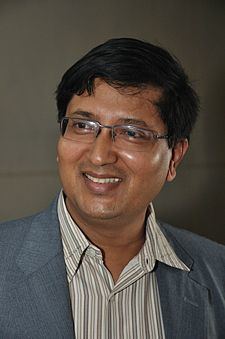Role Physicist Citizenship Indian | Nationality Indian Name Sandip Chakrabarti | |
 | ||
Born November 15, 1958 (age 66) Malda(WB), India ( 1958-11-15 ) Institutions S. N. Bose National Centre for Basic SciencesIndian Centre for Space Physics, Kolkata Institution S.N. Bose National Centre for Basic Sciences, Kolkata | ||
Doctoral advisor William David Arnett | ||
Dr sandip chakrabarti cd release
Sandip Chakrabarti is a leading Indian astrophysicist. He developed a computer model to show how life on Earth could have originated in outer space. Sandip K. Chakrabarti was born on 15 November 1958 at Malda, West Bengal (India) and is the fourth son of Sri Bijoy Bhusan Chakrabarti and Renuka Chakrabarti. His mother Renuka Chakrabarti is the granddaughter of the sister of Aghornath Chattopadhyay, father of [Ms. Sarojini Naidu] Sarojini Naidu, a freedom fighter and first governor of UP after independence. He is married to Dr. Sonali Chakrabarti, daughter of Prof. J.N. Chakrabarti, a Physicist.
Contents
- Dr sandip chakrabarti cd release
- Bhajo gou rango aarohan sandip chakrabarti others 2010
- Chronology 1
- References
From his childhood he was interested in astrophysics. In school days he had a laboratory at home where he used to perform all the experiments and more which were done at school. At the age of sixteen, inspired by Daniken's fictions, he wrote to Prof. Martin Schmidt at Caltech, the precise value of Hubble constant and the rate of loss of energy by the sun and used his reply to compute when Mars was at the habitable zone and when the earth was going to be out of this zone etc.
After finishing his Bachelor of Science from Ramakrishna Mission Residential College, Narendrapur in Physics Honours in 1979 (and becoming topper of Calcutta University) he went to IIT, Kanpur to complete his M. Sc. Degree in Physics in 1981. He joined the Physics Dept. of the University of Chicago in 1981 to complete PhD work. Within a year he completed a paper with Robert Geroch and X.B. Liang on a Theorem on "Time like Curves of limited acceleration in General Relativity". Prof. S. Chandrasekhar then asked him to solve the Dirac Equation in Kerr black hole geometry. In 1984 this work was also got published in Proc. R. Soc. Subsequently, he concentrated on black hole astrophysics, received his Ph.D. in 1985 and went to Caltech as a R.C. Tolman Fellow. Major work in this period includes nucleosynthesis around black holes with Prof. W.D. Arnett. After a brief period at ICTP, Trieste where he completed a few definitive work on the formation of shocks in transonic/advective flows around black holes he joined Tata Institute of Fundamental Research in Mumbai in November 1988 where he worked till 1996 before joining [S.N. Bose National Centre where he is a Senior Professor now (2008). He was at NASA Goddard Space Flight Centre (1994-1995) as a Senior Associate selected by National Research Council. He had been a member of the Executive Committee of Commission-28 (Galaxies) of International Astronomical Union (IAU, 1994-2000). He is a life-member of the IAU and a member of the American Astronomical Society. Recently, He was awarded DSc (Honoris causa) by Gour Banga University (2015). As of March, Google Scholar citation=7400 with h-index 40.
The main focus of the research area of Prof. Chakrabarti is the hydrodynamic and radiative properties of astrophysical flows around black holes and other compact objects. He showed that the accreting matter must be transonic and should have standing, oscillating and propagating shocks. He and his collaborators studied many aspects of these flows and showed that the black hole accretion must have non-Keplerian component which plays a major role in deciding the observational properties. He wrote the first monograph on “Theory of Transonic Astrophysical Flows” (World Scientific Pub. Co., Singapore; 1990). He has completed over 500 research articles and written or edited several books and conference volumes. Thirty one students have completed Ph.D. Thesis under his supervision and several are currently working. According to him the black hole astrophysics is basically the astrophysics of sub-Keplerian flows and CENBOL, the centrifugal pressure dominated boundary layer around black holes. The oft-cited work of Chakrabarti and Titarchuk (Astrophysical journal, 1995) brings out the concept of two-component flows. Indeed, more and more observational results, which include the spectral and timing properties of all the black hole candidates generally support his view that black holes also have a dissipative region around it which is non-Keplerian.
Sandip K. Chakrabarti was the first scientist to suggest that the Gamma Ray Bursts are the birth cry of black holes at his presentation in 1995 3rd Hunsville, Alabama Conference on Gamma Ray Bursts. Recently, Scientists observed a conclusive evidence of this birth cry
With his wife, Dr. Sonali Chakrabarti, a few papers were written on the evolution of the complex molecules during star formation. With a couple of Ph.D. scholars they have been able to show that even simple amino acids and bases of DNA molecules such an Adenine could also formed. The results of complex molecule formation depend on our knowledge of the reaction cross-sections and pathways and thus their exact abundances are liable to be revised.
Prof. Chakrabarti's interest took new turns with the foundation of a new Space Science related institute named Indian Centre for Space Physics (ICSP) of which he is the founding General Secretary and also the head of all the Academic activities. There Prof. Chakrabarti is involved in research works in several topics which range from Very Low Frequency (VLF) studies of ionosphere, planetary ring dynamics, Astrobiology, X-ray data analysis, testing and evaluation of payloads and developments of detectors for X-ray astronomy. In his leadership more than 100 low-cost balloon missions have been launched with payloads less than 5 kg to near space (up to 42km) and very high quality science is carried out. Presently there are several campuses of ICSP where about 15 students are completing their work towards PhD. ICSP is also a Sister Institute of Calcutta University.
